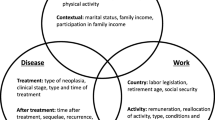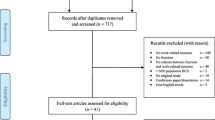Abstract
Background
Each year, the number of breast cancer (BC) cases increases in Brazil and worldwide. In addition, BC affects women of working age who need to resume their jobs after treatments. This is an observational, cross-sectional study that investigated the association of physical symptoms and work tasks with upper limb disability and return to work in BC survivors.
Methods
Sociodemographic, labor, clinical and surgical aspects, and physical incapacity of the upper limbs of 62 women diagnosed with BC were evaluated through a questionnaire of our own and the disability of the arm, shoulder, and hand (DASH) questionnaire. The data were analyzed by the IBM Statistical Package for Social Sciences SPSS version 20.0 and a significance of p < 0.05 was adopted. Logistic regression and odds ratio were used to verify the level of association between work tasks and pain with return to work, and multiple linear regression verified the association of physical symptoms with upper limb functionality.
Results
The work tasks associated with non-return to work were raising objects above the head (OR 3.64, 95% CI 1.26–10.51), lifting objects of more than 5 kg (OR 2.88, 95% CI 1.02–8.13), and loading objects of more than 5 kg (OR 3.93; 95% CI 1.14–10.07). The pain in the upper quadrant homologous to the surgery explained 64% of the variance in physical incapacity of the upper limbs.
Conclusions
There is an association of labor tasks that require upper limb strength and range of motion with non-return to work, and also pain in the upper quadrant homologous to the BC with reduction in the functionality of the upper limbs.
Similar content being viewed by others
References
World Health Organization. GLOBOCAN 2012: Estimated cancer incidence, mortality and prevalence worldwide. 2014 [updated 2018 July 23]. http://gco.iarc.fr/today/fact-sheets-cancers?cancer=29&type=0&sex=0. Accessed 18 Jan 2019.
Instituto Nacional do Câncer. Ministério da Saúde. Estimativa 2018: Incidência de Câncer no Brasil. [updated 2018 April 10]. http://www.inca.gov.br/estimativa/2018/index.asp. Accessed 18 Jan 2019.
Luo SX, Liu JE, Cheng AS, Xiao SQ, Su YL, Feuerstein M. Breast cancer survivors report similar concerns related to return to work in developed and developing nations. J Occup Rehabil. 2018;28:1–10.
Sun Y, Shigaki CL, Armer JM. Return to work among breast cancer survivors: a literature review. Support Care Cancer. 2017;25(3):709–18.
Zomkowski K, de Souza BC, da Silva FP, Moreira GM, de Souza Cunha N, Sperandio FF. Physical symptoms and working performance in female breast cancer survivors: a systematic review. Disability and rehabilitation. 2018;40(13):1485–93.
Waltho D, Rockwell G. Post–breast surgery pain syndrome: establishing a consensus for the definition of post-mastectomy pain syndrome to provide a standardized clinical and research approach—a review of the literature and discussion. Can J Surg. 2016;59(5):342.
Loh SY, Musa AN. Methods to improve rehabilitation of patients following breast cancer surgery: a review of systematic reviews. Breast Cancer Targ Ther. 2015;7:81.
Duijts SF, Egmond MP, Spelten E, Muijen P, Anema JR, Beek AJ. Physical and psychosocial problems in cancer survivors beyond return to work: a systematic review. Psycho-Oncology. 2014;23(5):481–92.
ILO. INTERNATIONAL LABOUR OFFICE. International Standard Classification of Occupations: Structure, group, definitions and correspondence tables. Genebra: ILO, 2012.
Bijker R, Duijts SF, Smith SN, de Wildt-Liesveld R, Anema JR, Regeer BJ. Functional impairments and work-related outcomes in breast cancer survivors: a systematic review. J Occup Rehabil. 2017;28:1–23.
Wennman-Larsen A, Alexanderson K, Olsson M, Nilsson MI, Petersson LM. Sickness absence in relation to breast and arm symptoms shortly after breast cancer surgery. Breast. 2013;22(5):767–72.
Sandberg JC, Strom C, Arcury TA. Strategies used by breast cancer survivors to address work-related limitations during and after treatment. Women’s Health Issues. 2014;24(2):e197–204.
Ministério da Saúde. Agenda nacional de prioridades de pesquisa em saúde: Brasil. Brasília, DF, 2015.
Cheng PL, Dumas GA, Smith JT, Leger A, Plamondon A, McGrath MJ, Tranmer JE. Reproducibility of a task description questionnaire for working pregnant women. Work. 2006;26(4):389–97.
Sperandio FF, Krawulsi LA. Investigando a tarefa e os fatores de risco em gestantes trabalhadoras: tradução e adaptação transcultural do “Task Description Questionnaire” no Brasil. Revista Digital-Buenos Aires 2007. pp. 112.
da Rosa PC, Moreira GM, Mochizuki L, Sperandio FF. Reproducibility of task description questionnaire among brazilian pregnant workers. Man Ther Posturol Rehabil J. 2018;16:1–5.
Wang L, Guyatt GH, Kennedy SA, Romerosa B, Kwon HY, Kaushal A, Parascandalo SR. Predictors of persistent pain after breast cancer surgery: a systematic review and meta-analysis of observational studies. Can Med Assoc J. 2016;188:E352–61.
Hudak PL, Amadio PC, Bombardier C, Beaton D, Cole D, Davis A, Punnett L. Development of an upper extremity outcome measure: the DASH (disabilities of the arm, shoulder, and hand). Am J Ind Med. 1996;29(6):602–8.
Orfale AG, Araujo PM, Ferraz MB, Natour J. Translation into Brazilian Portuguese, cultural adaptation and evaluation of the reliability of the Disabilities of the Arm, Shoulder and Hand Questionnaire. Braz J Med Biol Res. 2005;38(2):293–302. https://doi.org/10.1590/S0100-879X2005000200018.
Field A. Descobrindo a estatística usando o SPSS. Porto Alegre, Brazil; 2009.
de Almeida Rizzi SKL, Haddad CAS, Giron PS, Pinheiro TL, Nazário ACP, Facina G. Winged scapula incidence and upper limb morbidity after surgery for breast cancer with axillary dissection. Support Care Cancer. 2016;24(6):2707–15.
Fourie WJ. Considering wider myofascial involvement as a possible contributor to upper extremity dysfunction following treatment for primary breast cancer. J Bodyw Mov Ther. 2008;12(4):349–55.
Crosbie J, Kilbreath SL, Dylke E, Refshauge KM, Nicholson LL, Beith JM, Spillane AJ, White K. Effects of mastectomy on shoulder and spinal kinematics during bilateral upper-limb movement. Phys Ther. 2010;90(5):679–92.
Pavan PG, Stecco A, Stern R, Stecco C. Painful connections: densification versus fibrosis of fascia. Curr Pain Headache Rep. 2014;18(8):441.
Sun W, Chen K, Terhaar A, Wiegmann DA, Heidrich SM, Tevaarwerk AJ, Sesto ME. Work-related barriers, facilitators, and strategies of breast cancer survivors working during curative treatment. Work. 2016;55(4):783–95.
Shamley DR, Srinanaganathan R, Weatherall R, Oskrochi R, Watson M, Ostlere S, Sugden E. Changes in shoulder muscle size and activity following treatment for breast cancer. Breast Cancer Res Treat. 2007;106(1):19–27.
Harrington S, Padua D, Battaglini C, Michener LA, Giuliani C, Myers J, Groff D. Comparison of shoulder flexibility, strength, and function between breast cancer survivors and healthy participants. J Cancer Surviv. 2011;5(2):167–74.
Sagen A, Kaaresen R, Sandvik L, Thune I, Risberg MA. Upper limb physical function and adverse effects after breast cancer surgery: a prospective 2.5-year follow-up study and preoperative measures. Arch Phys Med Rehabil. 2014;95(5):875–81.
Fabro EAN, Bergmann A, Silva BDA, Ribeiro ACP, de Souza Abrahão K, da Costa Leite Ferreira MG, de Almeida Dias R, Thuler LCS. Post-mastectomy pain syndrome: incidence and risks. Breast. 2012;21(3):321–5.
Runowicz CD, Leach CR, Henry NL, et al. American cancer society/American society of clinical oncology breast cancer survivorship care guideline. CA. 2016;66(1):43–73.
Yang EJ, Park WB, Seo KS, Kim SW, Heo CY, Lim JY. Longitudinal change of treatment-related upper limb dysfunction and its impact on late dysfunction in breast cancer survivors: a prospective cohort study. J Surg Oncol. 2010;101(1):84–91.
Bouknight RR, Bradley CJ, Luo Z. Correlates of return to work for breast cancer survivors. J Clin Oncol. 2006;24(3):345–53.
Hayes SC, Battistutta D, Parker AW, Hirst C, Newman B. Assessing task “burden” of daily activities requiring upper body function among women following breast cancer treatment. Support Care Cancer. 2004;13(4):255–65.
Smoot B, Paul SM, Aouizerat BE, Dunn L, et al. Predictors of altered upper extremity function during the first year after breast cancer treatment. Am J Phys Med Rehabil Assoc Acad Physiatr. 2016;95(9):639.
Funding
This study was financed in part by the Coordenação de Aperfeiçoamento Pessoal de Nível Superior—Brazil (CAPES)—Finance Code 001.
Author information
Authors and Affiliations
Corresponding author
Ethics declarations
Conflict of interest
The authors declare that they have no conflict of interest.
Research involving human participants
All procedures performed in studies involving human participants were in accordance with the ethical standards of the institutional research committee and with the 1964 Helsinki declaration and its later amendments or comparable ethical standards. This study approval was granted by the Ethics Committee from Santa Catarina State University, under Protocol number 50685415.4.0000.0118.
Informed consent
Informed consent was obtained from all individual participants included in the study.
Additional information
Publisher's Note
Springer Nature remains neutral with regard to jurisdictional claims in published maps and institutional affiliations.
About this article
Cite this article
de Souza Cunha, N., Zomkowski, K., Fernandes, B.L. et al. Physical symptoms and components of labor tasks associated with upper limb disability among working breast cancer survivors. Breast Cancer 27, 140–146 (2020). https://doi.org/10.1007/s12282-019-01004-y
Received:
Accepted:
Published:
Issue Date:
DOI: https://doi.org/10.1007/s12282-019-01004-y




